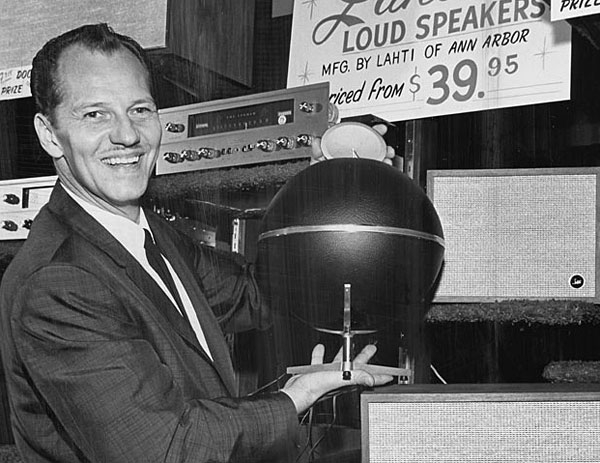| Columns Retired Columns & Blogs |
That is news to me. The article is from 1965, and JGH is referring to a "boom-box business" 15 years prior.

First, what's new this year? Very little, really. The only genuinely new innovations are in the pickup field: the elliptical stylus and the 15° standard vertical tracking angle. There are plenty of new products, as always, but by and large, to day's new developments are nothing more than extensions of yesterday's trends.
Transistors, of course, are with us more than ever, and as designers gradually lick their original problems—hiss, easy over load and inherent vice of the output stage, tube adherents are being left with less and less to claim in the way of superiority. A few of the top-priced new items—the Ortofon elliptical pickup, the Ampex MR-70 tape recorder, and the Acoustech Model 10 speaker–amplifier system—have actually set new all-time standards for fidelity, but most of the improvements in this year's component crop have been effected in the middle-price category.
Average equipment performance has taken a bigger forward step this year than it has during the previous five years, thanks to transistors, lower-mass pickups, and a growing conviction among speaker manufacturers that the public may conceivably be interested in natural sound. There's still entirely too much screech and boom being passed off as high fidelity, and there are an awful lot of lousy transistorized components riding the crest of the current solid-state fad, but the average high-fidelity system today is noticeably cleaner and more transparent than ever before.
Unfortunately, recordings continue to get worse and worse. Most record manufacturers appear to have abandoned any pretense of realism, and are making recordings into artistic creations divorced from any existing standards of fidelity. Commercial four-track 7½-ips tapes, which have never quite equaled the better discs in terms of clarity and hiss, look as if they may soon be replaced by 3¾-ips releases, with a further reduction in audio quality. All of which brings us to our department of prescience.
In view of the most recent developments in pickups and, particularly if 3¾-ips be comes the new commercial tape standard, we predict that discs will finally win the long-protracted "war of the media" and will become the standard medium for perfectionists. Tape, probably in cartridges or in conjunction with automated playback machines, will ultimately take over the average home "hi-fi" market.
The new Acoustech Model 10—a combination stereo amplifier and Janszen full-range electrostatic speaker system—illustrates another trend that's been gathering momentum in recent years and may well take off this year or next: The integration of mutually interdependent components.
"Universal" arms and cartridges and amplifiers and loudspeakers have pretty much come to the end of the line as far as predictable perfectionism is concerned. Today, anyone who pairs cartridge A and tonearm B, or amplifier A and speaker B, runs the risk of getting a combination that will not do full justice to any of the components. There are not enough detailed specifications about any of them to allow the buyer to select suitable complements, so all we can do is buy a combination and hope for the best. The future, we believe, will bring increasing numbers of integrated pickup systems and amplifier–speaker systems.
A few integrated pickups like the Shure Studio Dynetic and the Weathers FM and Professional Stereo systems have been around for a long time, and Ampex, KLH, James B. Lansing, and Quad have been matching amplifiers and speakers for several years, too. Some other speaker and amplifier manufacturers have "joined up" with one another (for example, Marantz and KLH, Dynaco and Acoustic Research and, most recently, Acoustech and Janszen Labs, footnote 1), and we expect to see this trend become Standard Operating Procedure in the future.
Anything else in the way of trends?
Well, loudspeakers are getting bigger again, thank heavens, and prices go Up, Up, Up. This is another trend we don't expect to see reversed, although we can console ourselves (no pun intended) with the fact that the quality of the stuff we're paying for is going up along with the price.
As a matter of fact, average high fidelity, by today's standards, is coming to cost so much that we would not be at all surprised to see an open split between the hi-fi market and the high-fidelity market. Most of the manufacturers who have been trying to sell components to a mass market will, we believe, be forced to choose between making good products for golden ears or crap for the crass.
In other words, we expect to see within the next couple of years another high-fidelity revolution, similar to the one that torpedoed the boom-box business 15 years ago. We couldn't be more pleased at the prospect.—J. Gordon Holt

I assume the 'console' stereos of the late 1950's. Capehart comes to mind. Philco and others. But 15 years is 1950, when Mantovani invented his original "wall of sound" effect for string orchestras - that wall of sound being designed to play well on the circa 1950 mono consoles.

As I read this 51 year old article, I kept thinking that with a few minor changes it could pretty easily be applicable in current times. I was especially amused at Mr. Holt's observation that prices are going up, up, up. His assertion that it was not likely to be reversed was as correct in 1965 as it is 51 years later.

It was 1965, and the triumph of tape cassettes in home use was predicted, though not in so many words. Missed on the tape speed (actually hit 1 7/8!) but not the cartridge-type loading. And discs (LP, then CD, then back to LP!) did win out for distribution of high-quality sound (if the record company was willing to produce it).
Otherwise, yes, much could translate to today.